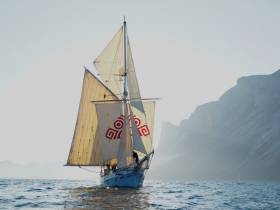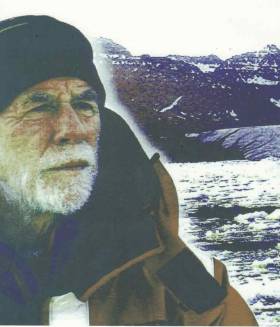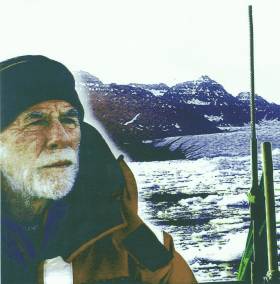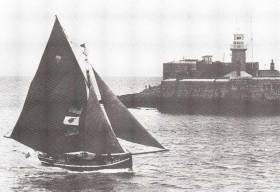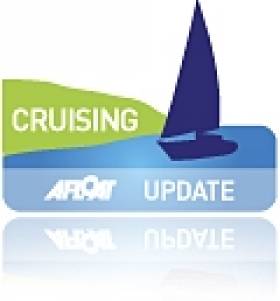Displaying items by tag: Paddy Barry
The Ilen’s Gary Mac Mahon & Paddy Barry are Sailors of the Month (Cruising) for September
The long story of the re-birth of the 1926-built 56ft Conor O’Brien trading ketch Ilen of Limerick was acquiring an almost wraith-like aspect until in 2019 – the restoration job completed – she undertook the very tangible 5000 miles Salmons Wake voyage to Greenland for inter-cultural exchange, research into salmon migration, and data-acquisition on climate change. Project Director Gary MacMahon – whose unflinching faith has kept this extraordinary concept moving ahead – was skipper for the outward passage from Ireland, whiled seasoned voyager Paddy Barry – who was aboard throughout the time away from Ireland – brought Ilen home safely across the restless North Atlantic in unsettled early Autumn conditions.
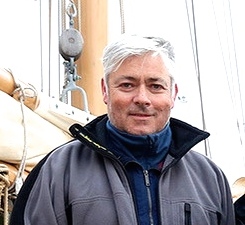 Gary Mac Mahon aboard Ilen in Nuuk – his sustained vision resulted in the restored Ilen’s successful voyage to Greenland. Photo: Chelsea Canavan
Gary Mac Mahon aboard Ilen in Nuuk – his sustained vision resulted in the restored Ilen’s successful voyage to Greenland. Photo: Chelsea Canavan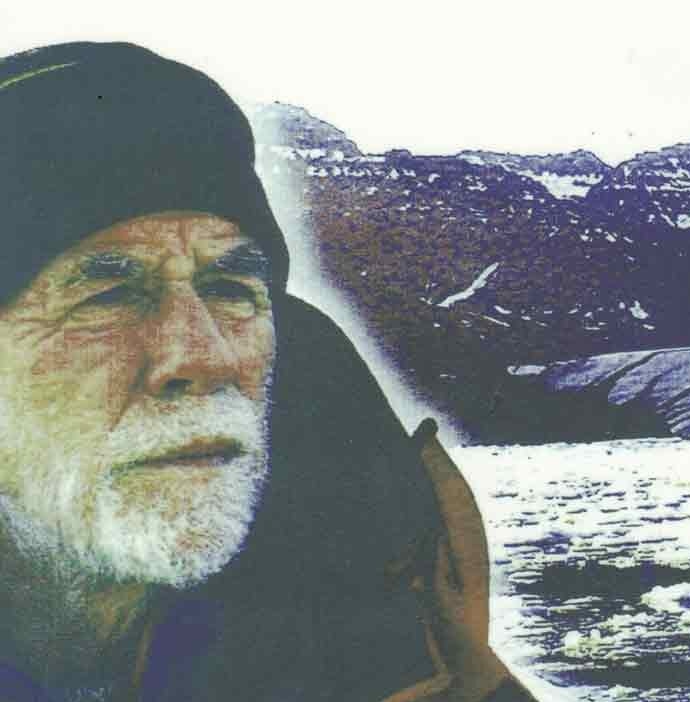 A man of the sea and the mountains and the ice – Paddy Barry safely skippered Ilen home from Greenland across a restless Autumnal North Atlantic
A man of the sea and the mountains and the ice – Paddy Barry safely skippered Ilen home from Greenland across a restless Autumnal North Atlantic
Paddy Barry's 'So Far So Good, An Adventurous Life' is a Super Memoir, Says Pete Hogan
Following WM Nixon's review of the launch of Paddy Barry's book So Far So Good, An Adventurous Life last September, artist and Round–the–World Sailor Pete Hogan recommends the memoir of the Irish sailor who has followed St Brendan’s wake both actually and metaphorically.
France has its hard men, like Eric Taberly. England has Bill Tilman, sailing to mountain and ice. Ireland has Paddy Barry and he has written a super memoir of an adventurous life.
I’ve known Paddy since around 1984 when he was preparing to take his hooker Saint Patrick across the Atlantic to New York. Which he went on to do. I have followed his sailing exploits ever since. They are so many that I am unable to list them here but they are all listed in this absorbing memoir which he has written.
Paddy, grows up in Cork and Dublin of the 40’s and 50’s. He hits the workforce in the early 60’s, describing those hard times and good times in Ireland with sympathy and balance. He does not complain but gets on with the job and lives life to the full even if, in those frugal days, things were different. This is not a tirade against church and state. Courtship, marriage and family are deftly handled. Overseas work as far afield as San Francisco and Malawi are sketched in.
Building projects in Ireland read like a fascinating social history.
Gradually boats and sailing start to become more important in his life. In 1973 he buys the hooker Saint Patrick, the eureka moment, surely an imaginative, momentous and courageous thing to do. It sets him on his path and is to dominate his life for the next 29 years.
The Saint Patrick’s restoration, all of her adventures, her rebuilding as well as her sad end, are related. But Paddy does not look back. Sailing continues to dominate his life and he develops an interest in mountaineering. Tilman-like he finds mountains in inaccessible places and climbs them or brings along others to climb them.
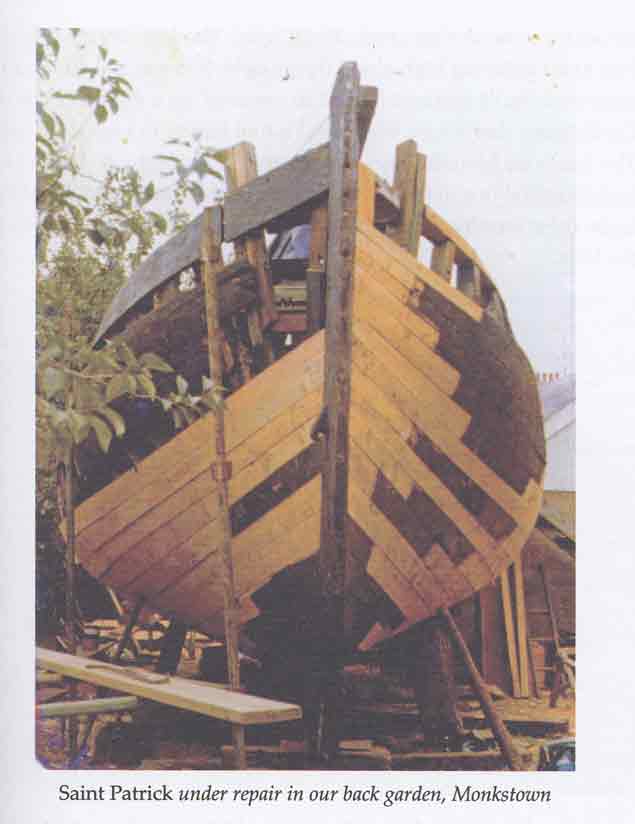
The Northwest and Northeast passages, numerous trips to the ice, the re-enactment of the Shackleton crossing to South Georgia are just a few of the highlights of the book. The full list is impressive indeed.
Paddy writes in an understated, modest style. Sometimes the self-effacing humour is lost in the understatement. His engineer’s sensibility aims for accuracy of detail and completeness rather than exaggeration or hyperbole. The achievement is glossed over and he sets his sights on the next adventure.
He follows in St Brendan’s wake both actually and metaphorically. It is not stated but it is obvious that Paddy’s voyaging is the pilgrimage of his life, the expression of a deep spirituality. Paddy’s quiet demeanour and earnest style inspires a wonderful band of followers to embark on his voyages with him. Hard men, (and they are usually men), they all get a mention and a compliment. Thus it must have been for St Brendan and his faithful band of acolytes as they sailed forth on their quest.
It is easy for the single hander to sail off on an adventure in any sort of vessel to any destination no matter how foolhardy or ill prepared. The single hander has only themselves to consider. To recruit a full crew, some of whom have never sailed before and bring them over the horizon requires a much higher level of responsibility and leadership. To bring them back home safely is a requisite. To still be on speaking terms with one another is an added bonus. This Paddy consistently achieves, voyage after voyage and the crew are happy to sign up for the next adventure.
The Irishness of Paddy and his achievement is a consistent leitmotif of the book. He sails forth as an ambassador for the sailors of Ireland. It is important to go as far as the sailors from any other nation have gone but also to have the craic and do it in a proud Irish style. To go yachting is not really in the Gaelic tradition but Paddy and his crew embrace it. They bring their music, smiles and cead mile failte to distant lands and peoples living on the edge.
 Voyaging to Iceland in 2011 on An Seachran
Voyaging to Iceland in 2011 on An Seachran
‘So Far so Good’ by Paddy Barry deserves to take its place on the book shelf beside the ‘Navigatio’ of St Brendan and ‘Across Three Oceans’ by Conor O’Brien.
I recommend this book thoroughly as a testament to Irish voyaging, cruising and adventuring. Paddy announces his retirement in the final pages of his book. Henceforward he will confine himself to the bays and hills of his beloved Connemara. He will be a hard act to follow.
Pete Hogan
Buy a copy of the Paddy Barry's So Far So Good, An Adventurous Life at €19.95 here
Lecture: Adventures in Antarctica & Launch of a Autobiography 'So Far, So Good' by Paddy Barry
#Lecture - Friends of Glenua are to have a lecture 'Adventures in Antarctica' and launch of an autobiography 'So Far, So Good' by Paddy Barry this Thursday 2 November at 20:00.
The venue will be in the Poolbeg Yacht & Boat Club, Ringsend, Dublin and where there will be an entry fee of €5 in aid of the RNLI.
Paddy Barry has led an adventurous life land and sea. His crossing of the Atlantic in his Galway hooker, St Patrick, was a just a prelude to a series of ever more ambitious voyages and expeditions. These include traversing the North West and North East Passages through the Artic ice cap.
Paddy was joint leader and skipper of the Tom Crean for the South Aris expedition to Antartica in 1997. He has been presented with numerous awards, including the coveted Blue Water Medal of the Cruising Club of America, in recognition of his achievements.
In his talk, Paddy will narrate how he and his six fellow Irishmen organised the South Aris expedition to recreate the 800 mile voyage of Ernest Shackleton from Elephant Island to South Georgia in a 23 foot lifeboat. A near ‘wipe out’ didn’t deter the South Aris expedition from laying a brass plaque on behalf of the Irish people at Shackleton's grave at Grytviken, South Georgia.
His talk will be followed by the launch of Paddy’s recently published autobiography, So Far, So Good-An Adventurous Life. Purchase the book online here.
Paddy Barry, Ireland’s Great Man of the Oceans & the Mountains, Has a Marvellous Tale to Tell
A Paddy Barry book launch is like no other writes W M Nixon. In fact, as with just about everything to do with this extraordinary man of the sea and the hills, a Paddy Barry book launch is unique unto itself across the entire spectrum of social gatherings anywhere in the world.
The setting was new to many of us - the hospitable Teachers’ Club on Parnell Square in the heart of Dublin’s north city. Our teachers, you’ll be glad to know, look after themselves very well. But they look after their guests even better. And there, right at the urban epicentre of the real city, the attractive Georgian town-house was packed to the rafters with people who exuded the outdoor life, whether it be on lone mountain-top, remote moorland, distant island, or rolling ocean, great people all there to celebrate Paddy Barry.
There were also many from the world of Irish culture in its broadest sense, particularly Irish Gaelic culture. And there were notable representatives of the international civil engineering profession, for Paddy Barry in his exceptionally busy existence has interacted with many people’s lives and many interests, and continues enthusiastically to do so.
 A man of the mountains and the sea. Paddy Barry at high latitudes, among ice and steep places
A man of the mountains and the sea. Paddy Barry at high latitudes, among ice and steep places
But as he was going to turn 75 this month, he reckoned a stock-taking was in order, and the result is a book of 37 chapters which takes us on a whirlwind tour of a life well lived and still being well lived at full throttle, a courageous life of great adventures seen through despite setbacks which would have stopped many lesser men.
It’s a very high protein read. A professional author could comfortably make half a dozen books out of it. But as ever, Paddy is in a hurry to get on with it in a tale which sees an early episode in his sailing career being an involvement with fellow-engineer Mick Cotter in partnership in a trapeze-using International 505 dinghy. They raced this wonderful sailing machine with the Dublin Bay fleet, but also cruised extensively, including going entirely unaccompanied from Roundstone out to the Aran Islands. And then, in the days when the Rose of Tralee contest was seen as a festival of opportunity, they took the 505 along with them behind the car to Tralee, with the happy notion that it might prove to be something of a babe magnet.
But soon Paddy was developing his lifelong love for Galway hookers, and having found the mighty St Patrick of maybe 1911 vintage mouldering away in the tiny harbour of Goleen in West Cork, of all places, he eventually got her home to his back garden in Monkstown where patient wife Mary - like the boat, she’s also a saint - had to live with a boatyard and a huge boat in the decidedly compact back garden. Meanwhile, her husband somehow found the time and energy between day jobs like building the Poolbeg chimneys to undertake a massive re-build.
In such circumstances, being a neighbour of Paddy Barry needs somebody special, but as ever Paddy is lucky as his neighbour these days is the ever-special Carrie Crowley, who gave us an entertaining account of what it’s like living next door to such a clan, and also revealed that although she’s not a sailor herself, Paddy’s new book “So Far, So Good” (the comma is everything) is itself so fascinating that she read it from cover to cover, and proved that with quoting some of the choicest episodes from it.
 You can certainly tell this book by its cover. Shortly after this image of St Patrick was taken among the ice off Greenland, the arch collapsed. But it’s not quite as lethal as it seems. St Patrick is clear on the other side, and never went through the arch, though there’s a rumour the photographer’s dinghy might have done so. Photo: Adrian Spence
You can certainly tell this book by its cover. Shortly after this image of St Patrick was taken among the ice off Greenland, the arch collapsed. But it’s not quite as lethal as it seems. St Patrick is clear on the other side, and never went through the arch, though there’s a rumour the photographer’s dinghy might have done so. Photo: Adrian Spence
So if you want find out about the incredible voyages of the St Patrick and how Paddy came to the mountains as well, you’ll just have to buy this book – it’s only €20 - and get reading. But try to pace yourself, for it really is very high protein and the narrative rattles along to tell things like how Paddy navigated the Arctic Circle with Jarlath Cunnane in Northabout and how, after the sad loss of St Patrick when she broke from a mooring in Glandore, Paddy realized the insurance wouldn’t remotely cover a re-creation of this very special boat.
So he went in a different direction completely, and bought a boat desined by German Frers of the Argentine, a slightly out-dated alloy-hulled 45ft offshore racer from the Adriatic, which he reckoned would do well in ice cruising. The many successful mountaineering voyages since to high latitudes and steep and icy place by Ar Seachran, with her forgiving alloy hull, have amply demonstrated the good sense of his judgment.
And a sweet touch for a Galway Bay traditional boat enthusiast is that Ar Seachran is designed by a Galway man. German Frers is descended from Argentine national hero Patricio Lynch, who was originally Patrick Lynch from Galway, but was press-ganged into the Royal Navy, where he made good his escape by leading a successful mutiny aboard a captured French warship which he and his motley crew sailed to Argentina, where their liberated vessel became the flagship of the nascent Argentine navy.
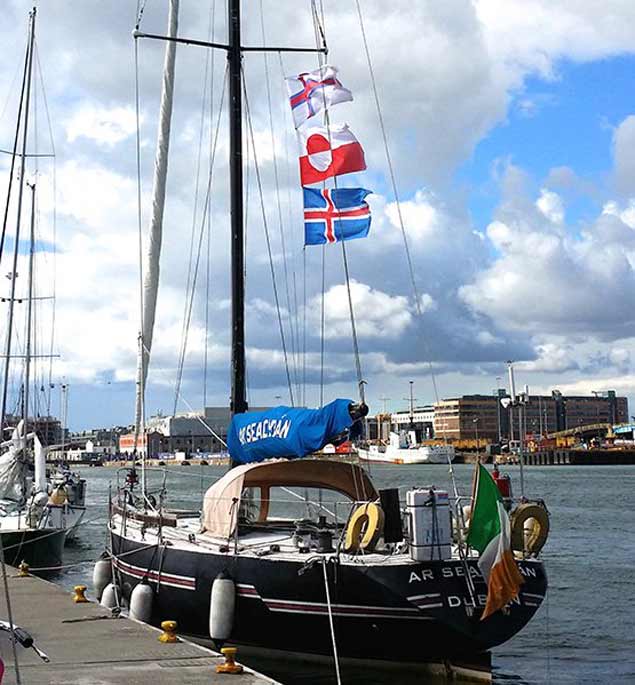 The 45ft alloy-built Frers-designed former racer Ar Seachran, which Paddy Barry has successfully modified for use as an expedition vessel. She is seen here at Poolbeg shortly after returning from a cruise to East Greenland. Photo: Tony Brown
The 45ft alloy-built Frers-designed former racer Ar Seachran, which Paddy Barry has successfully modified for use as an expedition vessel. She is seen here at Poolbeg shortly after returning from a cruise to East Greenland. Photo: Tony Brown
This remarkable line of descent means that any owner of a Frers design not only gets a boat designed by a Galway man, but they also get a boat designed by Che Guevara’s cousin. This was just the sort of info which hit the button at this week’s party in the Teachers’ Club, where the highly representative assembly of outdoorsmen buying the new Paddy Barry book by the armful included Jarlath Cunnane and Jamie Young from far Mayo, Dr Mick Brogan of Kinvara and Ballyhaunis, Gary MacMahon of the Ilen Project in Limerick and Baltimore, and Johnny Rooney and Fionan de Barra of Dublin with many others from Paddy’s huge selection of crew and friends built up over the years.
And that’s only the sailing people. The mountain men and women were there in strength too, and they certainly add a new dimension, as Paddy found when one of them helped him to dry out the St Patrick at Poolbeg on the falling tide to re-anti-foul her before yet another sailing/mountaineering expedition.
They’d about four hours before the tide would have fallen enough to let painting commence, so the mountaineer suggested they go off and climb one of the nearer Wicklow mountains to pass the time. For normal mortals, that would be a day’s work and then some. But the two boyos went off and scaled the peak, then came back and painted those acres of bad mor underbody, and then floated her off as the tide made, finishing their day by putting St Patrick back on her mooring. With Paddy Barry, you pack a lot into just one day.
So Far, So Good by Paddy Barry at €19.95 Published by Liffey Press, Dublin is available to purchase via Afloat's Marine Marketplace click here.
Howth YC To Host Talk On The North Atlantic Crescent
#HowthYC - Ocean adventurer Paddy Barry will give a talk at Howth Yacht Club this Friday (22 January) on the North Atlantic Crescent, a voyage he undertook with friends from Ireland to Greenland via the Faroe Islands and Iceland.
All are welcome to the clubhouse for the evening of adventurous cruising tales hosted by the HYC Cruising Group. For more information contact the club via the website HERE.
As climber Gerry Galligan explains in his blog, Paddy Barry and his regular crew were planning a sailing-climbing trip to Iceland, East Greenland, then back to Iceland again on his boat Ar Seachrán.
Paddy’s trip was part of a wider journey of island-hopping from Ireland to Greenland and back by way of the Hebrides, Faroes and Iceland; re-tracing the likely voyages Irish monks such as St. Brendan made, centuries ago. This overall project was given a name, The North Atlantic Crescent Adventure 2015; our scope, one leg of it, was to sail to Greenland, attempt some climbs, ideally first ascents, of the coastal peaks of the Lemon mountain range, before sailing 240 miles down the coast to the village of Tasiilaq.
The seven were skipper Paddy, blacksmith and rifle-man Ronán Ó Caoimh, myself, and four old IMC hands: Frank Nugent, Harry Connolly, Peter Gargan and Paddy O’Brien. More from Galligan here.
Ireland's West Coast – Special Boats & Big Hearted Sailors
#historicboats – These days we're told of the growing disparity between the economic recovery of Ireland's eastern region, and the relative economic stagnation of some of the rest of the country. But W M Nixon suggests that, for one part of the western seaboard at least, there's a special vitality to life around boats which challenges this perception, and could usefully be emulated elsewhere. And he signs off with a thought-provoking conclusion.
Connemara, Conamara. Spell it as you wish, but The Land of the Sea on Connacht's most westerly coast fires the imagination and inspires the spirit. It's a place of the mind as much as a place of wild mountains where rocky inlets wind their way deep into rugged country. So while purists might define it exclusively as the much intertwined coastline with its myriad islands between Spiddal and Killary, many of the rest of us can be so inspired by that special Connemara quality that we reckon it runs all the way from Galway Bay to Achill. And anyone from that magic coastline, or indeed anyone who has been inspired by it, carries the spirit of Connemara with them wherever they may be.
The boat people you meet out there, each with their own unique and often ambitious maritime agenda, will send you on your way re-enthused about boats and places and their many possibilities. And when someone from another place or indeed another country decides that it's in Connemara their true self and fulfilment is to be found, far from being seen as exiles they are instead seen as a new focal points for their old groups, and their soul-mates from times past descend on them in Connemara for inspiration and mental re-birth.
This weekend, the boat men from Clondalkin in outer Dublin are journeying to Renvyle on the furthest far west coast to help one of their own in his boat restoration programme at a storm-battered corner on a bit of coast which was almost washed away in the winter's seemingly endless climatic violence.
The men of Clondalkin are the community group who built and sail and continue to lovingly maintain the large Galway Hooker Naomh Cronan. Recently, they've been busy enough with replacing some planks on their hefty big boat. But their key organiser Paul Keogh is mindful of the fact that one of their own, Paddy Murphy, is in the west, living on an Atlantic point out beyond the old Oliver St John Gogarty house which is now the hotel at Renvyle.
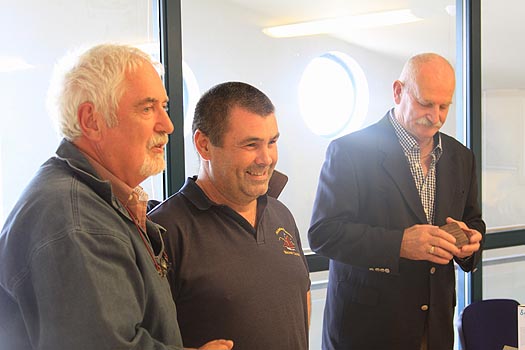
They dreamed the dream, and they made it happen. Key movers in the Naomh Cronan story were Stiophan O Laoire (left) and Paul Keogh, seen here at Poolbeg Y & BC as they come forward to accept a prize on behalf of the crew from Johnny Wedick, Hon. Sec. of the Dublin Bay OGA. Photo: Dave Owens
And between Paddy's house and the sea, beside a little hidden slipway which serves small boats which undertake the risky but rewarding challenge of harvesting Ireland's most fish-filled waters, the restoration project on the Aigh Vie is proving to be a demanding task. So this weekend the Keogh team – precise numbers unknown until everyone checks in this morning – are on site to re-caulk the Aigh Vie in a wild weekend of communal energy.
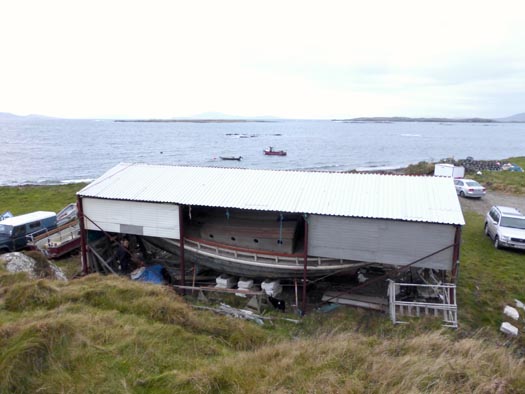
On the Atlantic frontier at Renvyle, the Aigh Vie is under her roof, tilted over to port to facilitate work under the starboard side of the hull. Photo: W M Nixon
For the Aigh Vie is one very special vessel. She's one of the Manx fishing nobbies which reached their ultimate state of development in the first twenty years of the 20th Century before steam power and then diesel engines took over. The nobby evolved to an almost yacht-like form through vessels like the 43ft White Heather (1904), which is owned and sailed under original-style standing lug rig by Mike Clark in the Isle of Man, and the 1910 Vervine Blossom, now based in Kinvara, which was restored by Mick Hunt of Howth, but he gave her a more easily-handled gaff ketch rig which looked very well indeed when she sailed in the Vigo to Dublin Tall Ships Race in 1998.
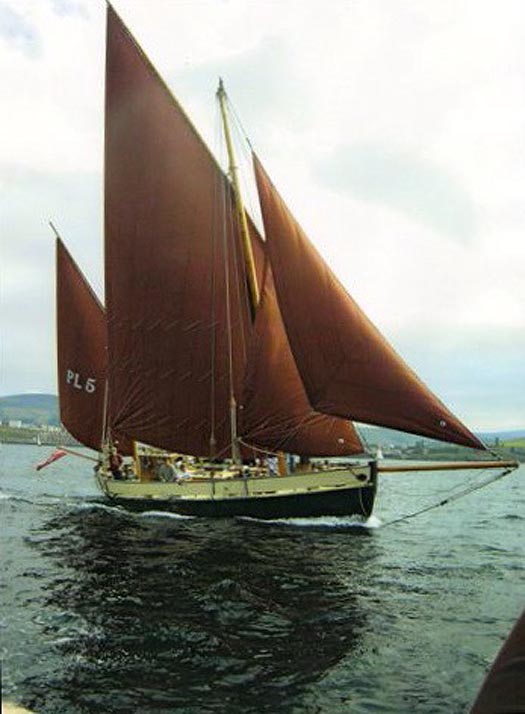
Mike Clark's Isle of Man-based 1904-built Manx nobby White Heather sets the original standing lug rig.
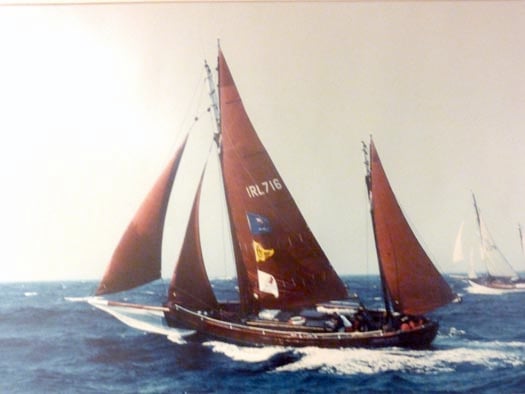
The 1910-built Manx nobby Vervine Blossom was restored by Mick Hunt in Howth, and is seen her making knots under her gaff ketch rig at the start of the 1998 Tall Ships Race from Vigo to Dublin. Photo: David Branigan
It takes quite something to outdo the provenance of these two fine vessels, but the story of Aigh Vie (it means a sort of mix of "good luck" and "fair winds" in Manx) is astonishing. It goes back to the sinking of the Lusitania by a German U Boat off the Cork coast in May 1915, when the first boat to mount a rescue was the Manx fishing ketch Wanderer from Peel, her crew of seven skippered by the 58-year-old William Ball.
They came upon a scene of developing carnage. Yet somehow, the little Wanderer managed to haul aboard and find space for 160 survivors, and provide them with succour and shelter as they made for port. In due course, as the enormity of the incident became clear, the achievement of the Wanderer's crew was to be recognised with a special medal presentation. And then William Ball, who had been an employee of the Wanderer's owner, received word that funds had been lodged with a lawyer in Peel on behalf of one of the American survivors he'd rescued. The money was to be used to underwrite the building of his own fishing boat, to be built in Peel to his personal specifications, and the result was his dreamship, the Aigh Vie, launched in 1916.
Over the years, the Aigh Vie became a much-loved feature of the Irish Sea fishing fleet. Tim Magennis, current President of the Dublin Bay Old Gaffers Association, well remembers her from his boyhood days in the fishing port of Ardglass on the County Down coast. In time, she was bought by the legendary Billy Smyth of Whiterock Boatyard in Strangford Lough, who gradually converted her to a Bermudan-rigged cruising ketch with a sheltering wheelhouse which enabled the Smyth family to make some notable cruises whatever the weather. His son Kenny Smyth, who now runs the boatyard with his brothers and is himself an ace helm in the local 29ft River Class, recalls that the seafaring Smyth family thought nothing of taking the Aigh Vie to the Orkneys at a time when the average Strangford Lough cruiser thought Tobermory the limit of reasonable ambitions.

Aigh Vie as she was when bought by Paddy Murphy from Billy Smyth of Strangford Lough.
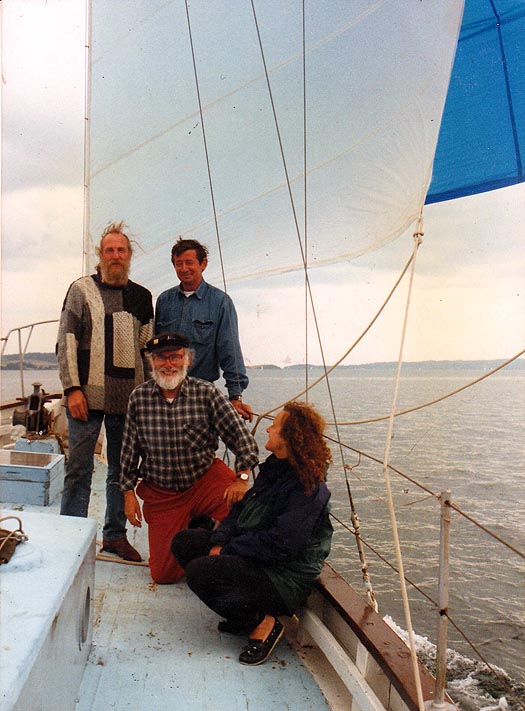
First sail with the newly-bought ship. Aboard Aig Vie heading for Dublin down Strangford Lough, the crew includes Paddy Murphy (left) and Tim Magennis (centre)
It's some years now since Paddy Murphy bought the Aigh Vie, and sailed her back to Dublin with his crew including Tim Magennis. But around the same time, Paddy was moving his base west to Renvyle, where he reckoned his skilled trade as a blacksmith, and his talents in traditional music and folklore, would provide him with a living in the area where he felt most at home.
As for the Aigh Vie, clearly she was reaching an age where work needed to be done. And he was minded to restore her to something more nearly approaching her original 1916 configuration. So somehow or other, he took the big boat west on a truck, managing to negotiate those little winding roads through Tully Cross and down to his place by the sea, where she went under a roof and work began.
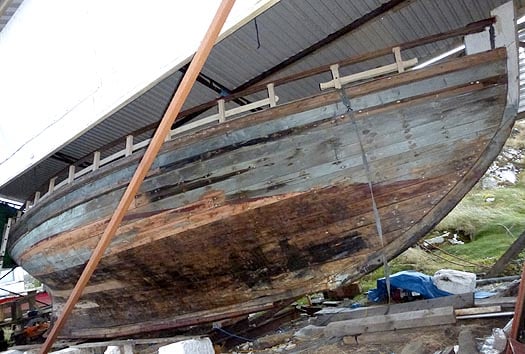
The hull of the 1916-built Aigh Vie as seen in Renvyle shows the remarkably yacht-like lines of the Manx nobby.........Photo: W M Nixon

.........in what was one of the last of the sailing type to be built before steam power took over. Photo: W M Nixon
It has been going on for some time now. The problem with being right on the frontier of Ireland's Atlantic weather is that no sooner do you start on some new area of timber repair and replacement, than the previous restoration section almost immediately starts to become weathered. Working largely on your own, you end up feeling you're going round in circles. So that's why the men from the Naomh Chronan are in Renvyle today to give the Aigh Vie project a mighty push forward.
For there's no doubt that while there's a lot done, there's a lot more still to do. But it does get done eventually if you keep the faith, and I was there back at the beginning of December to cheer Paddy along with all the usefulness of a hurler on the ditch. But at least I was accompanied by Dickie Gomes, who knows a thing or two about long-term boat restoration, as it took him 27 years to bring his 102-year-old Ainmara successfully back to life. But he did it so well that she won the Creek Inn Trophy for "Best in Show" at last summer's Peel Traditional Boat Weekend in the Isle of Man.

A bit of mutual support between two owners of vintage wooden boats – Paddy Murphy and Dickie Gomes in Aigh Vie's shed at Renvyle. Photo: W M Nixon
Nevertheless I've to confess that sometimes I wonder if wood is worth the trouble. Before getting to Renvyle, we'd called by with Jamie Young at Killary Adventure Centre for bit of a love-in with his alloy-built Frers 49 Killary Flyer which - as Brian Buchanan's Hesperia IV - was winner of the Round Ireland Race 1988 under the command of Dickie Gomes. Except that you won't see that fact in histories of the Round Ireland. Because for 1988's race, she sailed as the sponsored entry Woodchester Challenger, and thus was not entitled to the top prize, despite having the best corrected IOR time in the fleet.
But everyone in the know knows that Gomesie won, particularly the crew of Denis Doyle's slightly larger Frers sloop Moonduster. The two boats had been neck and neck running past the Blaskets, and suddenly Hesperia's spinnaker shredded. But Dickie had his crew so well drilled that one half of them had a replacement chute up and drawing before the other half had finished getting in the remains of the torn sail. The boat scarcely missed a beat in her rapid progress, and when the whole business was completed in about three minutes flat, there was a round of applause from Moonduster. You'd sportsmen doing the Round Ireland in those days.
As it happens, one of Hesperia's crew for that neat bit of work was Kenny Smyth, so it made it more than appropriate that we were going on to see the Aigh Vie on which he cut his offshore sailing teeth. But it was good to linger for a while at Jamie's snug place, and marvel at how he, with aid from the ingenious folk of the west, had contrived a slip and an angled trolley so that Killary Flyer can be hauled on site into a sheltered corner, for she's a big lump of a boat to be handling ashore.
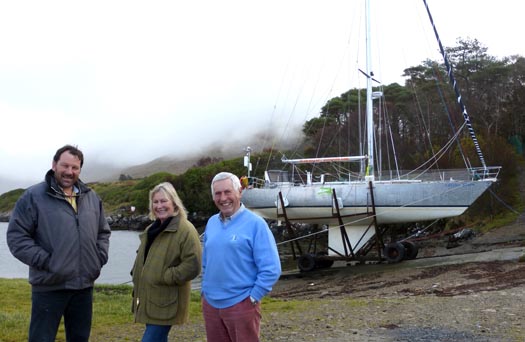
She's a big boat to be hauling on a slip in a remote corner of Mayo. Early December beside Killary Fjord, and Jamie Young of the Adventure Centre with Deirdre and Dickie Gomes and the Frers 49 Killary Flyer ashore for the winter. Deirdre was a fulltime member of the boat's crew when Dickie successfully skippered her offshore as Brian Buchanan's Hesperia IV. Photo: W M Nixon
It was some time in the New Year that we heard the shocking news. One of the most severe storms had twirled the Flyer up like a toy boat from her sheltered corner, and deposited this Frers masterpiece on her ear. Jammed in against the steep shore, she was trapped as the tide came in, and the hull was flooded with severe damage to the electrics and electronics.
But this is the west, where they're accustomed to overcoming massive challenges. The extraordinary Tom Moran of Clew Bay Boats played a key role in a salvage project which saw a temporary road being built so that a giant crane could be positioned for the delicate job of inching the big boat back upright. That done, she could then be moved to Tom's place at Westport for restoration to begin.
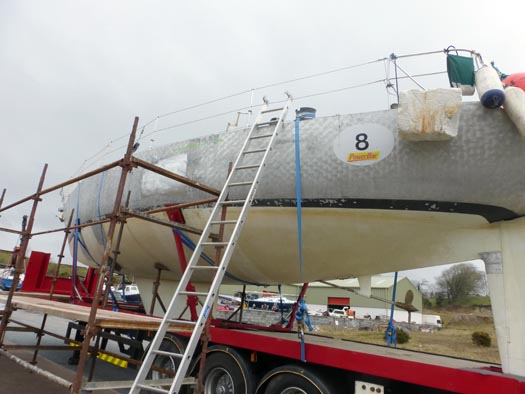
A couple of dents in aluminium? No problem. Following her brief episode of aviation, Killary Flyer's hull is already made good at Clew Bay Boats in Westport. Photo: W M Nixon
The whole business has been a marvellous advertisement for the effectiveness of hull construction using modern marine alloys. When aluminium was first created as the "Metal of the Future" two centuries ago, only the Emperor Napoleon could afford to have a cutlery set made in this exotic stuff. And though an early alloy boat put afloat in Lake Geneva performed reasonably well, as soon as a boat built with it was put into the salty sea, it just melted away.
But over the years the formulas have been adjusted to be corrosion proof in sea water, such that nowadays it's the ideal material for little boats which are going to have hard usage yet little maintenance, such as angling boats and the nippy craft used by rowing coaches.
And if you have a low-maintenance alloy hull yet give it a bit of cosmetic attention, it will look very well indeed, but it's not essential. As for the rough and tumble of life afloat, if you crash into a quay wall with a traditionally built wooden boat, she'll become shook from bow to stern – you never really know where the underlying structural damage ends, if at all. As for GRP and carbon or whatever, the damage will be more localised, but it still gets holed, and messily with it at that, while bulkheads may shift to an unknown degree
But a steel or aluminium hull will generally just be dented, and very locally at that. Repairs are manageable, even if it's skilled specialist work. So there's a lot in favour of steel and alloy. But steel rusts, and it never rusts quicker than in hidden pockets in the structure. But with remarkable advances in alloy welding and building techniques, the advantages of modern corrosion-free alloy construction become more evident every year for boats that are really going to be used, and not just seen as marina ornaments.
The Killary Flyer experience is ultimately a telling argument in favour of alloy construction. The hull was only dented in a couple of places where it was actually in direct contact with outcrops on the foreshore. Any dents have already been repaired by Tom Moran and his team, for they're able for anything to do with boats in any sort of material - I reckon if you wanted to build your dreamship out of resinated peat moss, then Tom would be game for the job.

Can-do people of the west – Mary and Tom Moran of Clew Bay Boats have successfully taken on many marine problems and projects. Photo: W M Nixon
Sorting out the interior systems is going to be more of a challenge, for Hesperia was originally Noryema X, built for Ron Amey in 1975. In a sense, there's a feeling of homecoming in the fact that she's being restored in Westport. If you head directly inland from that lovely little town, you're soon up in the mountains in the Joyce Country. And way back in 1975, the alloy hull of Noryema X was built by the renowned Joyce Brothers. Their fabrication workshop may have been in Southampton, but the family wasn't that long out of the mountains of far Mayo.
However, once the innovative Ron Amey had taken delivery of the hull of his latest Noryema from the brothers Joyce, he then took it to Moody's big shed at Bursledon on the Hamble for completion by the boatyard's craftsmen. I happened to be Bursledon-based in the early summer of 1975, and it really was all a wonder to behold.
Amey had installed a caravan in Moody's shed, and he lived in it while overseeing every detail of the new boat's fitout, while at the same time running his business empire of Amey Roadstone from a telephone in the caravan. It was said that the great man wouldn't be really happy with his new boats until the final jobs were completed just before the Fastnet Race in August, and after that he'd then start to think of the next one. But Noryema X was something special. She became the last of the racing line, and despite her enormous rig, Ron Amey then used her for eleven years of cruising in the Mediterranean which concluded with her sale to Brian Buchanan of Belfast Lough at Marseilles in 1986. She has been based on our island ever since, the source of much seagoing pleasure for hundreds of Irish sailors.
So bringing her back up to Amey standards is quite a challenge, as she's now part of Ireland's sailing heritage. But with Tom Moran they've someone who seems to have links with every maritime specialist in the country, and if he draws a blank in Ireland, his connections around the Solent marine industry seem pretty hot too.

Not quite where you'd expect to find an Arctic voyaging vessel, but Northabout seems at home in the Moylure Canal in the midst off Mayo fields. Photo: W M Nixon
Much encouraged by all this, for Clew Bay Boats is the sort of place where many good things seem possible, we then headed down to the Moylure Canal, a drainage waterway near Rosmoney at the head of Clew Bay where the great Jarlath Cunnane has created a tiny boat harbour and beside it a little place where, if so minded, he can build himself a boat.
Jarlath is the quintessential Connacht mariner, yet you'll never find him being sentimental about wooden boats. On the contrary, in the time I've known him he has built himself a steel van de Stadt 34ft sloop which he cruised very extensively, and more recently he took on the challenge of alloy construction to build the 44ft Northabout. Aboard this special boat, in teamwork with Paddy Barry, he has made cruises to remote and challenging places in voyages which, for most people, would have required full military logistical support.
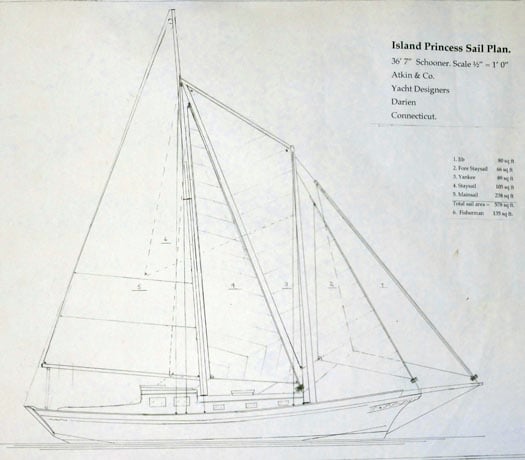
The new dreamship. Plans of the 37ft Atkins schooner which Jarlath Cunnane has been building over four years.
Knowing the scale of what he has done with her, it was bizarre to see Northabout sitting modestly in her berth in the little creek beside a Mayo field. But the presence of the long distance high latitude voyager was only part of the Moylure package. A few feet away in "the shed which isn't really a shed" was the new Cunnane boat, a sweet 37ft–Atkins schooner which, if you haven't yet appreciated the potential of good alloy boat construction, would surely win you over in a trice.

Good alloy construction, as seen here in the stemhead of the new schooner, can withstand comparison with any material. Photo: W M Nixon
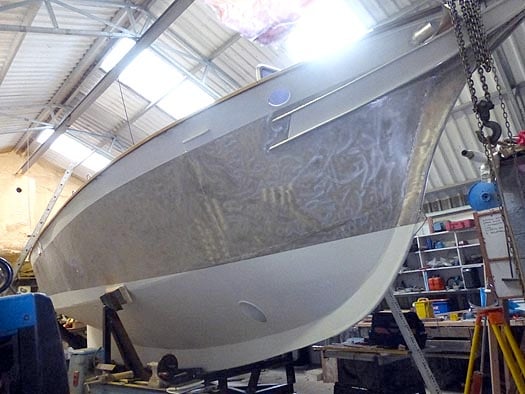
The new schooner has a workmanlike and handsome hull......Photo: W M Nixon

....which is aimed for comfort as much as speed, but she should be able to give a good account of herself in performance, and will be very comfortable for longterm periods on board. Photo: W M Nixon
Jarlath has taken four years on the construction, and when he gets to sailing the new boat, I'd say that the motto will be: "When God made time, he made a lot of it". This is a boat for leisurely cruising, a boat to enjoy simply being on board. In her finished state, she'll give little enough in the way of clues as to her basic construction material. Like Killary Flyer, and like Northabout too, she is in her own way a great advertisement for the potential of good alloy construction.
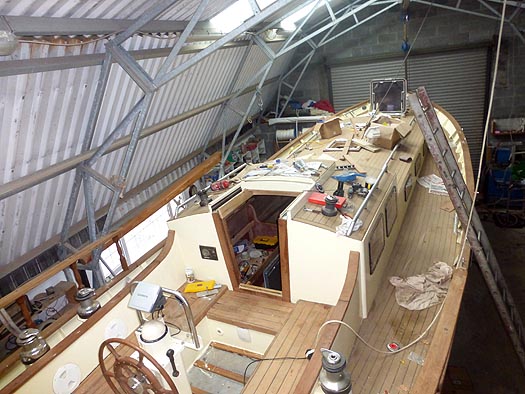
As completion nears, it becomes ever less apparent......Photo: W M Nixon
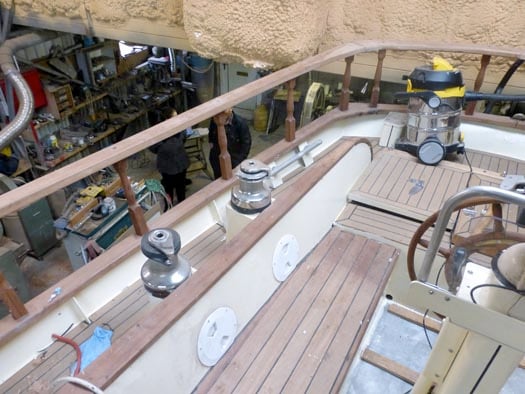
.....that the hull construction of the new schoner is in aluminium. Photo: W M Nixon
So we'll sign off this week with a special thought. As Irish life begins to move again, doubtless we'll soon hear increasing mutterings about the desirability of building a new Asgard sail training brigantine. Maybe we should keep the government out of it this time round, and build her through a voluntary trust organisation supported by public subscriptions and corporate donations. But however it's to be done, we should be starting to think about it.
And like many others, I've long thought that the ideal way forward would be with a steel hull built to Jack Tyrell's original Asgard II lines, which have a magnificently timeless quality to them. But I've changed my mind on that. Having seen what can be done with good alloy construction down in Mayo, and knowing the quality of alloy workboat construction being produced by firms like Mevagh Boatyard in Donegal and by the descendants of Jack Tyrrell among others at Arklow Marine Services in County Wicklow, it's difficult to escape the conclusion that the hull of the new ship should be built in aluminium.
It would be initially expensive, but it would confer great longterm maintenance advantages. And by going that way, we'd be able to provide all the double skins and safety bulkheads which will now be required without using up all available hull space, and without producing a boat so heavy she wouldn't be able to sail out of her own way. So let's hear it for an aluminium-hulled Asgard III.
St Brendan Voyagers Refused Access to Skellig
The crew of sailors, artists, musicians and historians on board Ar Seachrán - who are retracing the famous voyage of St Brendan - were refused permission to land on Skellig Michael, it has emerged.
The Kerryman reports that though some visitors are understood to have landed on the island in recent weeks, the OPW refused the Brendan's Voyage crew on health and safety grounds.
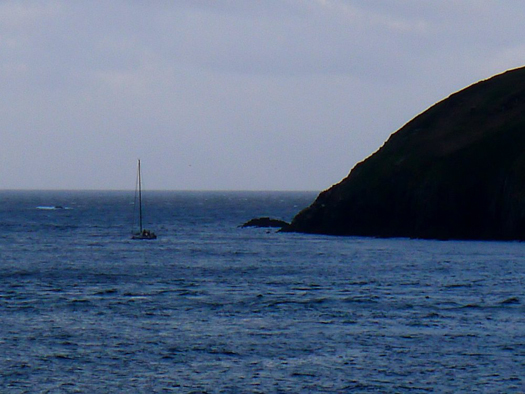
A spokesperson for the OPW said it requires at least 10 days notice to make preparations for any visitors and repair damage to pathways and buildings occurring over the winter months.
Dr Breandán Ó Ciobhán of the voyage party described the news as "very disappointing".
Ar Seachrán, a 45ft yacht owned by Paddy Barry - himself a veteran of unique ocean voyages - will continue on its journey up the west coast of Ireland and Scotland, by the Orkneys, Shetlands and Faroe Islands to Iceland.
Irish Cruising Club Present Fastnet Award to Killian Bushe
So whenever a high-powered strongly-resourced international challenge is taking shape, Bushe is the boat-builder of choice, favoured by leading designers and top skippers alike. But if you have a challenge in mind and he is top of the list, please join the queue.
For at the moment, he is immersed as leading consultant in building the new Groupama 4, the top French Volvo 70 for Franck Cammas. Before that, he built the two successful Ericsson boats for the last Volvo – they took first and fourth. In fact, he has built the overall winners of the last three Volvo races. And when Groupama 4 is launched in May and signed off for the race (which starts on October 29th) Bushe returns his focus to Sweden which is now his home, where he has been involved with the Artemis challenger for the America's Cup 2013.
For that project, the designer is Juan Kouyoumdjian, and the skipper is Paul Cayard. This is stratospheric stuff, but that's the level where Bushe operates. With more than thirty years of high tech boat building experience, and a string of success that is mind-boggling, he is the gold standard. But beyond that, he is still the Crosshaven kid who started his racing on his father George's Avocet (which George designed and built), and internationally he is the spirit of Cork sailing.
His renowned skill and knowledge in the use of advanced materials and composites is such that you'd expect him to be awarded a Honorary Doctorate in chemistry from some appropriate university. But in the meantime, his special place in Irish and world sailing was honoured on Saturday March 26th with his award of the Fastnet Trophy.
This trophy is co-ordinated by the Irish Cruising Club, and it operates in very broad brief. Initiated in 2005 with its first award to Paddy Barry and Jarlath Cunnane for their pioneering circuit of the Arctic via both the Northwest Passage and the Northeast Passage, its unique lineage has been maintained by such awardees as Robin Knox-Johnston, and the most recent one, centenarian circumnavigator Bill King of Galway.
The Fastnet Trophy is envisaged as highlighting a contribution to sailing which has a sense of the unique about it, and Killian Bushe is just the man. His international sailing achievements began back in 1976 when he was one of the crew that won the Half Ton Cup at Trieste in the Cork-built Silver Shamrock. They celebrated by sailing up the Grand Canal in Venice with spinnaker set. But gradually the boat-building took over, though Bushe sails with his family in Sweden whenever he can. That is what was being celebrated on Saturday night. Killian Bushe – very good sailor, extremely good boatbuilder.
Lecture: “The Newfoundland Voyage”
All are welcome, bar and refreshments and a voluntary contribution is appreciated. Further lectures will be held throughout the winter, mostly on the third Thursday of each month and in the Stella Maris. Note that the March lecture is due to be held on the 'fourth' Thursday of that month.
For further information about lectures and updates on the M.I.I's maritime museum in Dun Laoghaire, log on to www.mariner.ie
Lecture: "The Newfoundland Cruise"
in the Poolbeg Yacht Boat Club & Marina (PYBC). The next lecture is "The Newfoundland Cruise" by
Paddy Barry which is to held on Tuesday 2 November (1930 for 2000 hrs start).
For further information on the winter lecture series, contact Tim Magennis 087 2593113 For general information on the PYBC Tel: (01) 668 9983 or logon to www.poolbegmarina.ie/



























